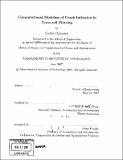Computational modeling of crack initiation in cross-role piercing
Author(s)
Chiluveru, Sudhir
DownloadFull printable version (8.787Mb)
Other Contributors
Massachusetts Institute of Technology. Computation for Design and Optimization Program.
Advisor
Raúl A. Radóvitzky.
Terms of use
Metadata
Show full item recordAbstract
Thle Mannesmann process is the preferred method in the oil industry for fabrication of hollow pipes. The critical phenomenon in this process is the formation of a small round hole at the center of the cylindrical billet ahead of the piercing plug. In this work the crack initiation that leads to the creation of tile small hole has been modeled. The Gurson-Tvergaard-Needlemnan model of porous plasticity is used to simulate the Mannesmann effect. The appearance of a crack at the center of the cylindrical bar is demonstrated and the stress profiles, plastic equivalent strain profiles and porosity distribution during the deformation process are analyzed. The influence of various parameters in the model on the evolution of porosity in tile specimen is studied. Other simple ductile fracture criteria that are proposed in literature are also implemented. An interface model for fracture using the discontinuous Galerkin framework combined with a cohesive fracture law is implemented. This approach and its advantages are illustrated in the application of tensile loading of a simple beam specimen.
Description
Thesis (S.M.)--Massachusetts Institute of Technology, Computation for Design and Optimization Program, 2007. Includes bibliographical references (p. 81-89).
Date issued
2007Department
Massachusetts Institute of Technology. Computation for Design and Optimization ProgramPublisher
Massachusetts Institute of Technology
Keywords
Computation for Design and Optimization Program.